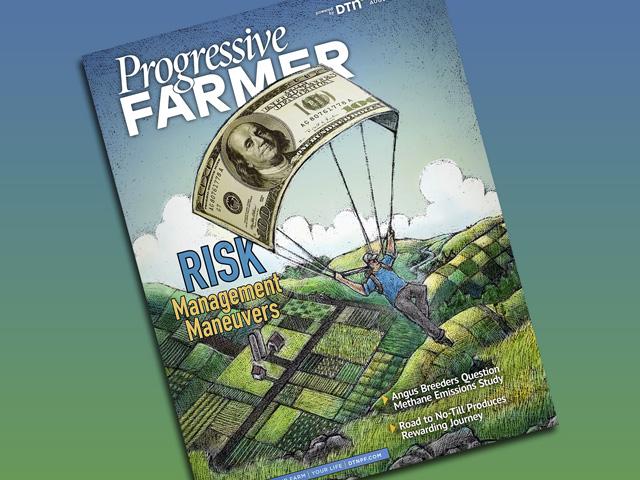Are Corn Residues Changing?
UNL Data: Grazing High-Yielding Corn Might Mean Less-Nutritious Residue
OMAHA (DTN) -- Cattle producers in the Corn Belt depend heavily on grazing crop residues to feed livestock with the most common cornstalks. As corn becomes higher yielding, this has led to speculation about the nutritional value of corn residues.
Recent research shows grazing residues can still be a viable option for livestock producers at proper utilization levels. However, a reduction in stocking rates might be needed when grazing higher-yielding corn residue.
INCREASING YIELDS AFFECT RESIDUES
In a presentation titled "Corn Residue Grazing: Current Recommendations and Adjustments Based on New Data" from the Three State Beef Conference, University of Nebraska-Lincoln (UNL) Extension Beef Systems Specialist Mary Drewnoski said advances in genetics in corn production are changing what is present in corn residues. See that presentation here: https://www.youtube.com/…. Specifically, higher-yielding cornfields appear to produce less biomass and the residue has slightly lower digestibility levels.
Drewnoski said UNL completed a two-year corn hybrid study to look closer at what was left in the fields after the combine rolls. Year one was in 2021 and included 24 hybrids at four different field stations and producer fields across the state. Year two was in 2022 with 26 hybrids in three different locations.
One obvious factor is less grain in residue today, she said. With properly set combines able to harvest nearly all the grain, very little grain remains in the field for grazing. Drewnoski said grain would be the most nutritious aspect for grazing cattle. Grain is 80% total digestible nutrients (TDN) and 9% crude protein (CP).
As corn hybrids have higher yields, there is less residue per bushel as yield increases. This makes sense as the plant is putting more energy into producing grain and less into plant material, she said.
However, the proportion of residue does change slightly in higher-yielding corn as the amount of husks and leaves increases a small amount, Drewnoski said.
Other than the grain, husks and leaves have the most nutritional value in corn residue compared to cobs and stems. Husks are high in energy at 60% TDN with leaves slightly lower at 42%. Both are low in protein with husks at 3% crude protein and leaves slightly higher at 6.5%.
The plots in the study averaged about 16% husks and 19% leaves in high-yield plots, slightly higher than in lower-yielding fields that were closer to 14%, she said.
P[L1] D[0x0] M[300x250] OOP[F] ADUNIT[] T[]
Drewnoski speculated that corn plants from these high-yielding hybrids were putting more of their resources into leaves and husks than in the stem of the plant.
"This is a positive (for grazing)," she said.
DECREASED DIGESTIBILITY
A not-so-positive turn for grazing corn residue in the study is a noticeable decrease in digestibility in high-yielding environments, Drewnoski said. The TDN in the studied residue saw a noticeable decline as corn yields increased, she said. This would be the total amount of energy available to livestock grazing the crop residue.
In 100-bushels-per-acre corn, husks had 74% TDN, leaves 59% and leaves and husks together were at 65%. At the 250-bushel-per-acre level, husks dropped to 67%, leaves fell to 54% and leaves and husks together declined to 60%.
Drewnoski said study results raise the question: Can producers meet cow nutritional needs with these changing corn residues? The short answer is yes, they can, but the margin for error is smaller, she said.
A late-gestation cow requires 60% TDN if she eats 1.8% body weight intake, so even with leaves and husks dropping to 60% TDN in high-yielding corn residue, this will still meet the energy requirements for grazing cattle, she said.
"We just have a little less leeway in these residues," Drewnoski said.
Taking this knowledge into consideration, those who graze high-yielding corn residue will have to lower their stocking rates to account for fewer digestible nutrients in the residue, she said.
The current UNL recommendation for grazing corn residue was one cow for one month for every 100 bushels of grain. This also takes into consideration UNL's recommendation to utilize 50% of leaf and husks while grazing residue.
A scenario would be a 160-acre cornfield that yields 250 bushels per acre with 150 cows grazing. Following the recommendations, the math works out to be 2.7 months -- or 81 days -- in this example.
Drewnoski said by calculating the same scenario with slightly less digestibility in the residue in the UNL study, the math works out to be only 71 days of grazing.
"In these high-yielding fields, we need to reduce our stocking rate by about 10%," she said.
WEATHER AFFECTS GRAZING
The weather has a large effect on both the available residue and how nutritious it is for livestock, Drewnoski said. Figuring out the amount of nutrients that exist and how long to graze is based on ideal weather conditions.
Two weather factors have a considerable impact on grazing crop residues.
Windy conditions is one, Drewnoski said. Wind can blow husks and leaves into the road ditch or other fields entirely. Knowing how important husks and leaves are to the digestibility of corn residue, smaller amounts make corn residue less nutritious for grazing, she said.
The other factor is a warm winter, which Nebraska saw for most of this winter, according to Drewnoski. Ideally, the ground is frozen when cattle graze during the winter months. In a warm winter, the ground is not frozen and trampling losses increase. Less residue is available to graze, she said.
"Our weather in Nebraska is often not ideal so you would want to factor this into grazing residues as well," Drewnoski said.
Russ Quinn can be reached at Russ.Quinn@dtn.com.
Follow him on the social platform X @RussQuinnDTN.
(c) Copyright 2024 DTN, LLC. All rights reserved.






